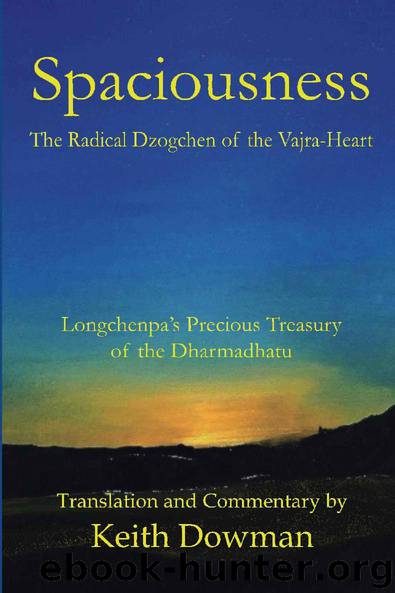Spaciousness: The Radical Dzogchen of the Vajra-Heart: Longchenpa's Treasury of the Dharmadhatu by Keith Dowman & Pelden Longchenpa

Author:Keith Dowman & Pelden Longchenpa [Dowman, Keith]
Language: eng
Format: epub
Publisher: Dzogchen Now! Books
Published: 2016-03-06T00:00:00+00:00
Canto Eight: Nonduality
Introductory
At the beginning of the twenty-first century, in the new age, the word “nondual” is a buzzword. This is a wake-up call for the Christian Church, but it also heralds new horizons in psychological theory and practice. In Dzogchen, “nondual” implies nondual perception. Nondual perception entails an inseparable unity of subjective mind, “the knower”, and the objective field, or what is known. Such a unity of subject and object implies the absence of any witness in the perceptual process. No “I” controls any given situation and nor is the “I” even a passive witness to mental events. This in turn implies a thought-free mind, because thought needs to be witnessed to be conscious in the dualistic consciousness of ordinary relative mind. Nondual awareness, therefore, is something completely beyond our ability to verbalize or to express in any way whatsoever. Thus the nondual is ineffable. We could leave it there, as the most rigorous nondual schools do, but Dzogchen while assuming total nondual rigor in nonmeditation experience, in atiyoga method, allows recognition of the nondual nature of mind by means of a concept, a doorway from the dual to the nondual.
The primary verbal association with nonduality in this Dzogchen context is spontaneity, wherein spontaneity denotes (as clarified in the previous canto) a totality experience free of all causes and conditions and therefore “naturally occurring”. Such an experience, of course, occurs only and uniquely in the matrix of the here and now. It occurs, then, in every moment of experience and experience itself is indeed spontaneity. Spontaneity and nonduality are the last verbal points of reference before the matrix of the now consumes us, before the final resolution.
Experientially, nonduality is said to have no point of reference. In other words the experience of nonduality cannot be said to happen, to have happened, or to have a possibility of happening. Thus, nonduality, like buddha, is unknowable. If there were a point of reference, there would be a witness to it and we know “the witness” is an aspect of the subjective knower, the inner aspect of dualistic perception. If any point of reference whatsoever persists, such as a candle flame, an embodiment, a visionary panorama, spaciousness or a sense of nonduality itself, then we are still caught in the cage of dualistic perception where self and other are separate, where subjective and objective aspects are reified as distinct entities. The “unraveling” of the specific characteristics of appearances has not yet reached the place where “all distinctions are smoothed away”, where a continuous state of totality obtains.
One of the antonyms of nonduality is bipolarity. If perceptual duality is the functional sensory manifestation of a loss of nondual awareness, then emotional bipolarity is its internal corollary. This emotional duality is not primary love-hate, pride-jealousy, positive-negative dualism; it is the secondary, derivative emotional polarity of hope and fear, which could be called sentiment. Our moods and thoughts can be categorized as one or the other, as either hope or fear, or somewhere on a median in between.
Download
This site does not store any files on its server. We only index and link to content provided by other sites. Please contact the content providers to delete copyright contents if any and email us, we'll remove relevant links or contents immediately.
The Way of Zen by Alan W. Watts(6289)
Ego Is the Enemy by Ryan Holiday(4958)
The Art of Happiness by The Dalai Lama(3847)
The Book of Joy by Dalai Lama(3698)
Why Buddhism is True by Robert Wright(3284)
Spark Joy by Marie Kondo(3087)
Shift into Freedom by Loch Kelly(3029)
Happiness by Matthieu Ricard(2884)
A Monk's Guide to a Clean House and Mind by Shoukei Matsumoto(2783)
The Lost Art of Good Conversation by Sakyong Mipham(2438)
The Meaning of the Library by unknow(2385)
The Third Eye by T. Lobsang Rampa(2172)
The Unfettered Mind: Writings from a Zen Master to a Master Swordsman by Takuan Soho(2158)
Red Shambhala by Andrei Znamenski(2071)
Anthology by T J(2046)
The Diamond Cutter by Geshe Michael Roach(1955)
Thoughts Without A Thinker: Psychotherapy from a Buddhist Perspective by Epstein Mark(1893)
Advice Not Given by Mark Epstein(1763)
Twilight of Idols and Anti-Christ by Friedrich Nietzsche(1762)
